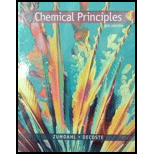
(a)
Interpretation: Value of
Concept introduction:
(a)
Answer to Problem 96CP
Value of
Explanation of Solution
Given Information: Total pressure at equilibrium is
Given reaction occurs as follows:
Since after
Total equilibrium moles are calculated as follows:
The formula to calculate mole fraction is as follows:
Moles of
Total Moles is
Substitute the value in above formula.
The formula to calculate mole fraction is as follows:
Moles of
Total Moles is
Substitute the value in above formula.
The formula to calculate partial pressure is as follows:
For
The value of
The value of
Substitute the value in above formula.
For
The value of
The value of
Substitute the value in above formula.
Expression for
Value of
Value of
Substitute the value in above equation.
Hence, value of
(b)
Interpretation:Equilibrium pressure of
Concept introduction: Chemical equilibrium is taken into consideration if rate of forward and backward reactions become equal. At this stage, both reactants and products have constant concentration. It can be studied in terms of pressure also. Equilibrium constant in pressure is denoted by
(b)
Answer to Problem 96CP
Equilibrium pressure of
Explanation of Solution
Given reaction occurs as follows:
ICE table in terms of pressure for the above reaction can be drawn as follows:
Expression for
Value of
Value of
Value of
Substitute the value in above equation.
Simplify to obtain the value of
Equilibrium pressure
Equilibrium pressure
Hence, equilibrium pressure of
(c)
Interpretation: Moles percentage of original
Concept introduction: Chemical equilibrium is taken into consideration if rate of forward and backward reactions become equal. At this stage, both reactants and products have constant concentration. It can be studied in terms of pressure also. Equilibrium constant in pressure is denoted by
(c)
Answer to Problem 96CP
Percent of
Explanation of Solution
ICE table in terms of pressure for the above reaction can be drawn as follows:
From the table net pressure for
Similarly net pressure for
Therefore extent of
Hence, percent of
Want to see more full solutions like this?
Chapter 6 Solutions
CHEM.PRINC.W/OWL2+REBATE+2 SUPPL.>IP<
- Lexan is a plastic used to make compact discs, eyeglass lenses, and bulletproof glass. One of the compounds used to make Lexan is phosgene (COCI2), an extremely poisonous gas. Phosgene decomposes by the reaction COCl2(g)CO(g)+Cl2(g) for which KP = 6.8 109 at 100C. If pure phosgene at an initial pressure of 1.0 atm decomposes, calculate the equilibrium pressures of all species.arrow_forwardConsider the following hypothetical reaction: X2(g)+R(s)X2R(g) R has a molar mass of 73 g/mol. When equilibrium is established, a 2.5-L reaction vessel at 125C contains 15.0 g of R, 4.3 atm of X2, and 0.98 atm of X2R. (a) Calculate K for the reaction at 125C. (b) The mass of R is doubled. What are the partial pressures of X2 and X2R when equilibrium is reestablished? (c) The partial pressure of X2 is decreased to 2.0 atm. What are the partial pressures of X2 and X2R when equilibrium is reestablished?arrow_forwardThe reaction, 3 H2(g) + N2(g) (g), has the fol lowing equilibrium constants at the temperatures given: atT=25°C,K= 2.8 X 104 at T = 500°C, A = 2.4 X IO"7 At which temperature are reactants favored? At which temperature are products favored? YVhat can you say about the reaction if the equilibrium constant is 1.2 at 127°C?arrow_forward
- For which reactions in Exercise 34 is Kp equal to K?arrow_forwardCalculate the pressures of all species at equilibrium in a mixture of NOCl, NO, and Cl2 produced when a sample of NOCl with a pressure of 10.0 atm comes to equilibrium according to this reaction: 2NOCl(g)2NO(g)+Cl2(g)Kp=4.0104arrow_forwardFor which of the reactions in Exercise 13.15 does Kc (calculated using concentrations) equal KP (calculated using pressures)?arrow_forward
- At a particular temperature, a 3.0-L flask contains 2.4 moles of Cl2, l.0 mole of NOCI, and 4.5 103 mole of NO. Calculate K at this temperature for the following reaction: 2NOCI(g)2NO(g)+Cl2(g)arrow_forwardKc for the decomposition of ammonium hydrogen sulfide is 1.8 104 at 25 C. NH4HS(s) NH3(g) + H2S(g) (a) When the pure salt decomposes in a flask, what are the equilibrium concentrations of NH3 and H2S? (b) If NH4HS is placed in a flask already containing 0.020 mol/L of NH3 and then the system is allowed to come to equilibrium, what are the equilibrium concentrations of NH3 and H2S?arrow_forward
 Chemistry for Engineering StudentsChemistryISBN:9781337398909Author:Lawrence S. Brown, Tom HolmePublisher:Cengage Learning
Chemistry for Engineering StudentsChemistryISBN:9781337398909Author:Lawrence S. Brown, Tom HolmePublisher:Cengage Learning Chemistry: An Atoms First ApproachChemistryISBN:9781305079243Author:Steven S. Zumdahl, Susan A. ZumdahlPublisher:Cengage Learning
Chemistry: An Atoms First ApproachChemistryISBN:9781305079243Author:Steven S. Zumdahl, Susan A. ZumdahlPublisher:Cengage Learning ChemistryChemistryISBN:9781305957404Author:Steven S. Zumdahl, Susan A. Zumdahl, Donald J. DeCostePublisher:Cengage Learning
ChemistryChemistryISBN:9781305957404Author:Steven S. Zumdahl, Susan A. Zumdahl, Donald J. DeCostePublisher:Cengage Learning
 Chemistry: Principles and ReactionsChemistryISBN:9781305079373Author:William L. Masterton, Cecile N. HurleyPublisher:Cengage Learning
Chemistry: Principles and ReactionsChemistryISBN:9781305079373Author:William L. Masterton, Cecile N. HurleyPublisher:Cengage Learning Chemistry: The Molecular ScienceChemistryISBN:9781285199047Author:John W. Moore, Conrad L. StanitskiPublisher:Cengage Learning
Chemistry: The Molecular ScienceChemistryISBN:9781285199047Author:John W. Moore, Conrad L. StanitskiPublisher:Cengage Learning





